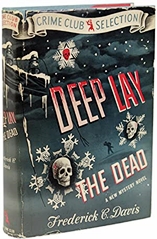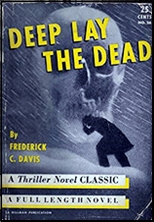Wed 8 Jun 2022
A 1001 Midnights Review: FREDERICK C. DAVIS – Deep Lay the Dead.
Posted by Steve under 1001 Midnights , Reviews[4] Comments
by Bill Pronzini
FREDERICK C. DAVIS – Deep Lay the Dead. Doubleday Crime Club, hardcover, 1942. Thriller Novel Classic #26, digest paperback, circa 1946.

An extremely prolific contributor to the pulp magazines, where he published at least 1000 stories (among them dozens of the Operator #5 “hero pulp” adventures), Frederick C. Davis began publishing mystery novels in 1937. He produced close to forty books over the next four decades — sixteen under his own name, one as by Murdo Coombs (A Moment of Need, 1947), and the balance under the pseudonym Stephen Ransome.
His fiction was among the most literate and entertaining of its day (if sometimes a little too casually paced), and stands up well to the test of time.
Deep Lay the Dead is arguably his best novel. Ex-Dartmouth mathematics professor, cipher addict, and mountain climber Rigby Webb comes to an isolated corner of eastern Pennsylvania to confront a retired doctor named Chandler, whom he suspects of pulling strings to first get him fired from Dartmouth and to then keep him out of the army.
His suspicions are accurate, but Chandler’s reasons are noble: He is working for the State Department and General Staff, attempting to design an “indecipherable cipher” so as to win supremacy over the Axis in signal communications. Getting Rig fired was the first of several tests of Chandler’s loyalty, all of which he has passed in admirable fashion.

Rig agrees to work on the cipher project with the doctor, but they don’t get very far with their collaborative efforts: One of the guests invited to Chandler’s country estate by his wife, Claire, is an enemy agent. Murder strikes, a howling blizzard renders the house party snowbound, and tensions escalate to a fever pitch as more violence erupts. Rig eventually unmasks the traitor and saves the day, and in so doing gets to use his mountain-climbing skills (but not in the way you might think).
This is a tightly plotted, suspenseful novel built around a classic mystery situation. There is also some intriguing background information on codes and ciphers. (Another of· Davis’s strong suits was his ability to weave information on unusual and/or esoteric topics into his narratives.) Davis did have a tendency to truncate his action scenes, and the climax, while exciting, is much too abrupt; but the book’s strengths more than make up for this and a few other minor weaknesses.
Davis created numerous series characters, for both his pulp stories and his novels. Professor Cyrus Hatch uses scientific methods and ratiocination to solve baffling crimes in several early novels, among them Coffins for Three (1938), Let the Skeletons Rattle (1944), and Thursday’s Blade (1947). And the semi-hard-boiled detective team of Schyler Cole and Luke Speare, who operate out of New York, is featured in such titles as The Deadly Miss Ashley (1950) and Drag the Dark (1953).
Deep lay the Dead is the only non-series novel to appear under Davis’s own name; several others were published as by Stephen Ransome. Ten of his Operator #5 pulp novels were reprinted in the Sixties and Seventies under the house pen name of Curtis Steele; these carry such titles as The Invisible Empire and Blood Rein of the Dictator and provide plenty of campy fun.
———
Reprinted with permission from 1001 Midnights, edited by Bill Pronzini & Marcia Muller and published by The Battered Silicon Dispatch Box, 2007. Copyright © 1986, 2007 by the Pronzini-Muller Family Trust.
June 8th, 2022 at 9:58 pm
My review of this same novel can be found here:
https://mysteryfile.com/blog/?p=77838
June 9th, 2022 at 9:54 am
Bibliographic note: This book also was published in a uniform “Crime Club” reprint set by Collier. There were at least eight volumes in the series, which provided a pretty good cross-section of the Crime Club books of the period. It’s a lot easier finding Deep Lay the Dead in this edition.
June 9th, 2022 at 10:36 am
Thanks, Jim. I’ve found an eBay seller who had five of them up for sale, including the one by Davis:
June 9th, 2022 at 8:28 pm
I’ve read and enjoyed many of his pulp stories and enjoyed the Hatch and Cole and Speare books I’ve read.
This one sounds like fun with all the qualities I’ve come to expect from Davis.
I wonder if that tendency to rush the action came from writing the plot heavy Operator #5 novels where, by the apocalyptic endings, there was often enough going on for an entire issue that had to be tied up as neatly as possible before the next month’s crisis?